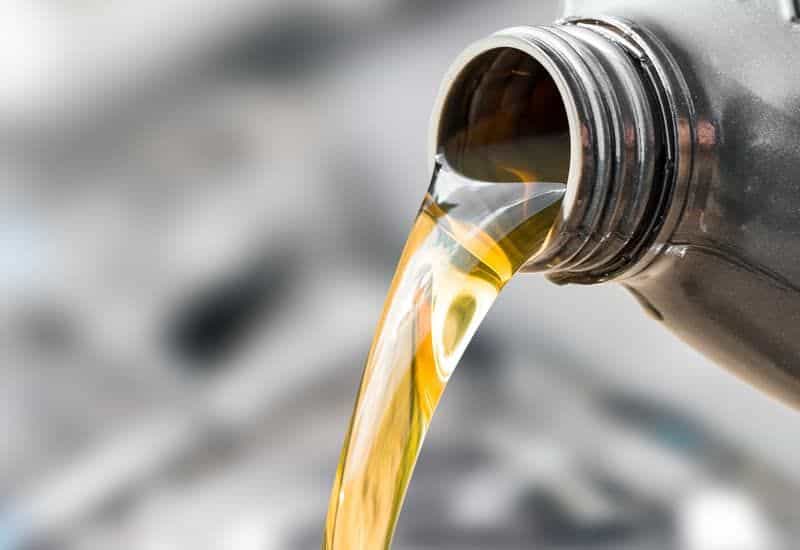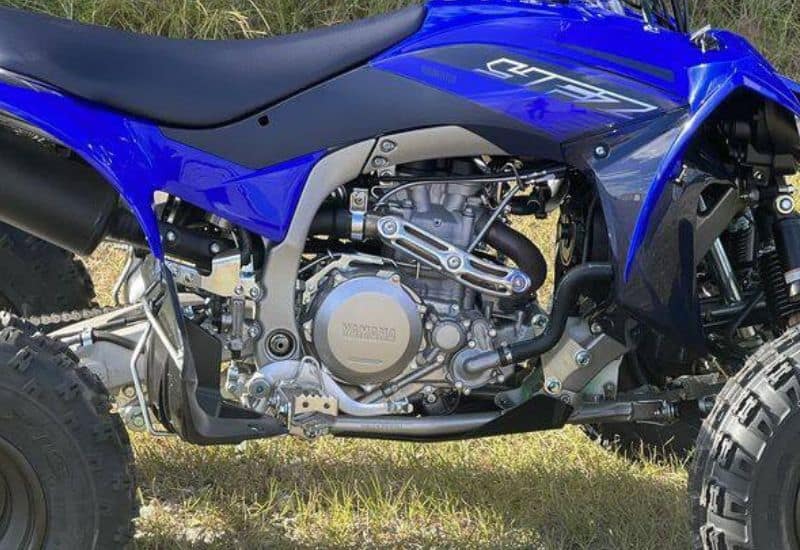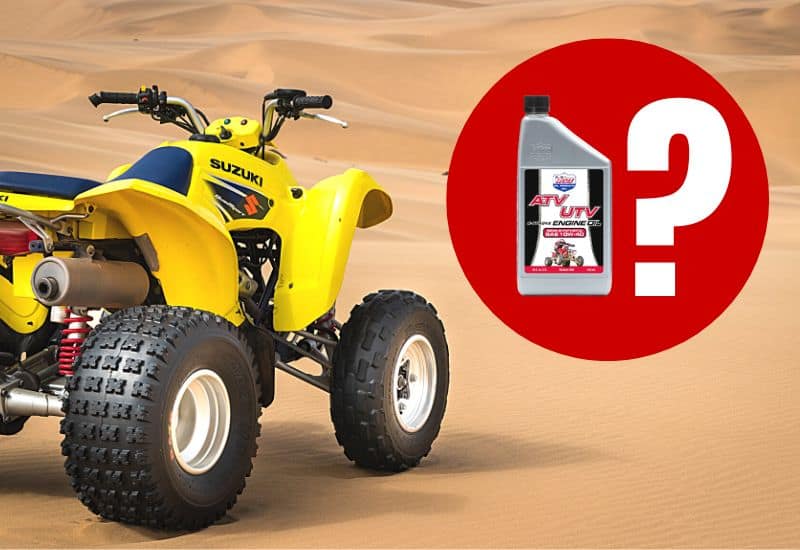All-terrain vehicles (ATVs) and their engines operate in tough and challenging riding conditions full of dirt, mud, dust, and water crossings.
Which can quickly contaminate and break down the engine oil meant to protect them.
So when does ATV oil go bad and when does it need changing?
This is exactly the question we intend to answer in this blog post.
Because changing the engine oil and filter at recommended intervals is one of the best ways to maintain and take care of your machine.
Key Takeaways
- Most ATV manufacturers recommend an oil change within the first 25 miles or 25 hours during the break-in period, followed by every 1,000 miles, 100 hours, or 6 months after that.
- Conventional ATV motor oil lasts about five years in unopened containers.
- Semi-synthetic and synthetic ATV motor oils will last seven to eight years in unopened containers.
How to Tell if Your ATV Oil Has Gone Bad
It’s generally recommended after the initial break-in period that you change the oil in your ATV every 1,000 miles or 100 hours of riding, depending on which comes first.
However, many riders will need to change the oil in their machines much sooner than this, as it may take them more than a year to rack up 1,000 miles or 100 hours of riding.
Which would exceed the time duration recommended between ATV oil changes, which is generally six months.
Motor oil needs to be changed at certain time intervals because oil slowly degrades inside an ATV engine over time, even if it’s not being used.
But how can you visually identify when it has gone past its prime?
Here are the most common signs that you should replace the engine oil:
- Discoloration – Fresh oil has a clear golden hue. As it oxidizes and thickens, the color changes to amber, brown, or black.
- Sludge Formation – Contaminants form deposits and debris that appear as thick black or brown sludge.
- Foul Odors – Bad oil smells rancid with a rotten egg odor from sulfur compounds or like gasoline from fuel dilution.
- Reduced Performance – Thick oil and engine deposits lead to hard starting, knocking noises, smoking, and loss of power.
If your ATV or its engine displays any of the above symptoms combined with an unknown or excessive oil age, it’s time for an oil change.
Waiting can cause early engine wear and even damage if the oil becomes too contaminated with debris, loses viscosity, or the oil level becomes too low to provide adequate lubrication.
Why & How ATV Oil Degrades Over Time

Even with minimal use, engine oil gradually loses effectiveness and goes “bad” over time.
In fact, engine oil can even go bad unopened sitting on the shelf, which is why all oil containers have expiration dates printed on them.
Below are some of the reasons why oil goes “bad” in time, even if its barely been used.
- Oxidative Thickening – Oil contains hydrocarbons that react with oxygen from air exposure leading to the formation of deposits, varnish, and acidity. This chemical process raises the oil’s viscosity causing thickness and discoloration.
- Mechanical Shearing – The extreme pressures and temperatures inside an engine break oil molecules into smaller less effective fragments. This shearing effect reduces lubrication quality over time.
- Contamination – Inevitable dust, dirt, moisture, unburned fuel, and metal particles mix with oil during ATV operation, which accelerates degradation. Even the finest particulates can damage internal components.
- Additive Depletion – Quality oils contain performance-boosting additives with anti-wear, cleaning, and anti-foaming properties. However, high temperatures and engine acids diminish their effectiveness over time.
Well-formulated synthetic oils withstand these aging factors better than conventional oils.
But no ATV lubricant lasts forever. That’s why routine oil monitoring and replacement is a must.
Signs You Need an Oil Change Despite Low Miles or Hours
While 100 hours of run time or 1,000 miles provides an estimate of when you should change the oil in your four-wheeler or quad, you should never rely on these milestones alone.
As you might need to change the oil in your ATV sooner, depending on how hard you ride, where you ride, and what you’re doing with the machine.
For instance, aggressive riding on extreme terrains or hauling and towing heavy loads can significantly increase the strain on your ATV’s engine, leading to oil break down faster than normal.
Under these conditions, it’s important to monitor the oil quality and level more frequently and to change the oil earlier.
As this proactive maintenance ensures that your engine is protected and that you’ll get peak performance and horsepower from your ATV.
Beyond just visually checking the oil though, you can also monitor the performance of the ATV itself, as this can also be a good indicator of when you might need to change the oil early.
For example, if you experience any of the below engine issues, you should change the oil as soon as possible, because while these issues may be a sign of more serious problems, changing the oil is a good first step.
- Knocking Sounds from the Engine
- Persistent Hard Starting
- Slow Cranking
- Reduced Compression
- Reduced Power and Acceleration
When it comes to engine oil it’s always better to be safe than sorry.
Playing it safe with earlier-than-normal oil changes can minimize wear and prevent failures down the road.
While you’ll spend a little more on oil, this small upfront cost is minor compared to major repairs or an engine rebuild!
What Happens if You Don’t Change ATV Oil Often Enough

It can be tempting to stretch oil change intervals to save money and effort.
But you might be less inclined to do so when you find out what happens inside an ATV’s engine when oil gets extremely old and dirty. (Spoiler alert – nothing good.)
Not regularly changing the oil in an ATV engine can cause a whole host of problems and lead to costly repairs, as you can see below.
- Thick Oil Cannot Properly Lubricate – This leads to metal friction and heat build-up, damaging engine surfaces.
- Increased Wear on Pistons, Bearings, and Other Components – This can lead to early part failures and extensive repairs.
- Oil Sludge Clogs Passages – Blocking oil flow further increases component wear and the potential for damage.
- Oil Oxidation Produces Acids and Varnish – These corrosive materials can damage internal surfaces.
- Ring Fouling, Oil Burning, and Loss of Compression – This leads to reduced performance over time.
- Complete Engine Failure Requiring Rebuild or Replacement – Worst-case scenario, oil left unchecked and unchanged for an extended period could require the entire engine to be rebuilt, which can easily exceed $1,000.
As you can see, skipping regular oil upkeep is like playing Russian roulette with your engine.
You might get away with it for a short while.
But catastrophic failures can happen without warning.
Storing ATVs Long-Term With Old Oil
Oil sitting motionless inside an engine for months or years continues to oxidize, thicken, and absorb contaminates.
This leads to a corrosive mess inside the engine over time,
Acids, deposits, and moisture condensation accumulate the longer the oil sits stagnant.
And these threats only amplify when seasonal temperature swings allow condensation to form inside the engine.
Because of this, all machines that will be stored for more than three months should ideally receive an oil change beforehand, or at a bare minimum before the first ride of the season.
This helps to prevent internal corrosion and ensures the internal components are well-protected.
Synthetic oils handle long-term storage better than conventional.
But regardless of which type of oil you use, an oil change is cheap protection to preserve internal engine health.
Can Used ATV Oil Be Reused or Recycled?
You should never reuse old or used engine oil for all the same reasons that you should change your engine oil regularly.
However, it’s important to properly dispose of used ATV oil, as you should never throw old oil in the trash, as it can contaminate the environment and take years to break down.
This is why most municipalities consider it hazardous waste and prohibit it from being thrown away or poured down the drain.
The good news, though, is that it has never been easier to properly dispose of used motor oil, as there are many places you can take it.
Best Places to Dispose of or Recycle ATV Oil
- Oil Change Centers
- Auto Part Stores
- City or County Recycling Centers
- Private Recyclers
- Community Collection Sites
Always handle waste oil responsibly to protect the local ecosystem, because after all this is where we spend most of our time riding.
Best Practices to Increase ATV Oil Longevity
The extreme operating conditions ATV engines face make frequent oil changes a must.
But certain proactive measures can help maximize the effective lifespan of your oil while also reducing contamination.
- Choose Quality Oil for Your Machine – Top-tier synthetic oils better withstand heat, oxidation, and contaminants. The right additive chemistry also slows aging. Using the manufacturer’s recommended viscosity grade is important as well.
- Perform Routine Air Filter Changes – Clogged air filters allow an abundance of engine-fouling dust particles to enter causing oil contamination. Stick closely to recommended filter cleaning or replacement schedules.
- Avoid Moisture Contamination – Use caution when riding through water crossings. Ingested water dilutes oil while also causing a contaminated breeding ground.
- Use Oil Additives – Anti-wear additives replenish protective surface films on engine parts as oil ages. Detergent additives help suspend contaminated particles. Both keep the oil working optimally longer.
Final Thoughts On ATV Oil
Engine oil is the lifeblood of every ATV.
Treat it as such by staying vigilant monitoring oil conditions and sticking to routine change intervals.
If in doubt, err on the side of changing your oil a little early. Your machine and wallet will thank you in the long run.
The small ongoing cost of fresh oil is minor compared to a damaged engine needing expensive repairs or replacement.
The good news though, with simple proactive oil upkeep, your ATV will continue delivering miles of worry-free fun on the trails for years to come.
Recent Posts
In recent years, off-road enthusiasts have been taking their adventures to the next level by installing UTV underglow lights on their side-by-sides. Which adds a unique visual appeal and improves...
Side by sides, also known as UTVs, are used by a wide range of outdoor enthusiasts from off-roaders to farmers to ranchers, and hunters. As these versatile machines offer a unique blend of...

